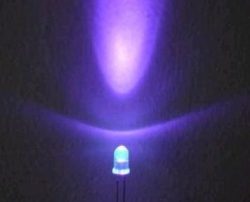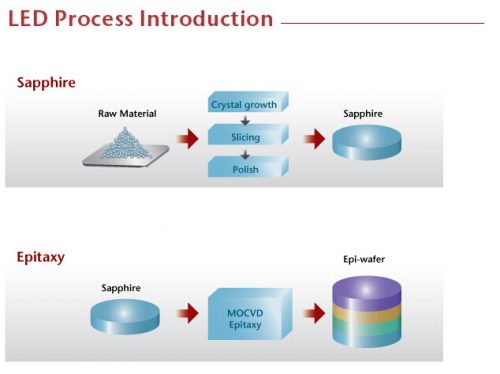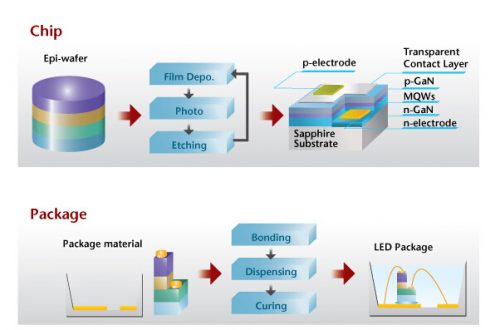PAM-XIAMEN can offer UV LED epi wafer, which is grown by our MOCVD range from 275nm to 405nm. Ultraviolet electromagnetic radiation, commonly known as UV, is used in many industries and applications. The emerging UV LED will be a competitive technology that can drive new innovative applications. UV-LED has a long service life and is more environmentally friendly than conventional mercury UV lamps.
1. Specifications of UV LED Epi Wafer
| Size | Orientation | Emission | Wavelength | Thickness | 기판 | Surface | Usable area | |
| PAM-50-LED-UV-365-PSS | 50mm | 0°±0.5° | UVA | 365 nm | 425um+/-25um | Sapphire | P/L | >90% |
| PAM-50-LED-UV-405-PSS | 50mm | 0°±0.5° | UVA | 405 nm | 425um+/-25um | Sapphire | P/L | >90% |
| PAM-50-LED-UVC-275-PSS | 50mm | 0°±0.5° | UVC | 275nm | 425um+/-25um | Sapphire | P/L | >90% |
2. The Structure of UV LED Epitaxy
PAM-190320-UV-LED
| Composition | 두께 |
| CTL | 5nm |
| P-ALGaN/GaN | – |
| EBL | – |
| MQW | – |
| SRL | 60nm |
| N-GaN (N-AlGaN) | – |
| U-GaN | – |
| AlN으로 | 25nm |
| PSS | – |
The UV Epi LED chip performances are below:
| BIN | VF1 | LOP1 | WLP1 | HW1 | INT1 |
| 1 | 3.77 | 28.9 | 366.1 | 17 | 12157 |
| 1 | 3.76 | 30.04 | 366.2 | 17.1 | 13281 |
| 2 | 3.73 | 22.07 | 366.3 | 17 | 8791 |
| 1 | 3.67 | 29.48 | 366.1 | 17.2 | 12961 |
| 1 | 3.73 | 21.06 | 366.1 | 17 | 8417 |
| 1 | 3.72 | 33.44 | 366 | 17.2 | 15812 |
| 1 | 3.73 | 37.23 | 366 | 17.4 | 18198 |
| 1 | 3.74 | 38.44 | 365.9 | 17.4 | 19148 |
| 1 | 3.75 | 38.84 | 366.2 | 17.5 | 18683 |
| 1 | 3.75 | 39.73 | 366.3 | 17.6 | 19625 |
3. About UV LED Epi Wafer Process
3.1 Making Semiconductor Wafer and Substrate
먼저 반도체 웨이퍼를 만듭니다. 특정 재료 구성 -GaAs, GaP 또는 그 사이의 일부 물질은 생산 된 LED의 색상에 의해 결정됩니다. 결정질 반도체는 고온 및 고압 챔버에서 성장합니다. 갈륨, 비소 및 / 또는 인광체는 정제되고 챔버에서 함께 혼합됩니다. 열과 압력을 액화하고 구성 요소를 함께 눌러 용액에 넣습니다. 이들이 챔버에서 가압 된 가스로 빠져 나가는 것을 방지하기 위해 일반적으로 액체 붕소 산화물 층으로 덮고 밀봉하여 ""서로 붙어 있어야합니다 "". 이를 액체 캡슐화 또는 Czochralski 결정 성장 방법이라고합니다. 그러나 UV LED의 경우 일반적으로 사파이어 소재가 사용됩니다.
둘째, 잉곳을 약 10mil 두께 또는 쓰레기 봉투만큼 두꺼운 매우 얇은 반도체 웨이퍼로 자릅니다. 표면이 매우 매끄러 워질 때까지 웨이퍼를 연마하여 표면에 더 많은 반도체 층을 쉽게 수용 할 수 있습니다. 원리는 그리기 전에 테이블을 연마하는 것과 유사합니다. 각 웨이퍼는 균일 한 구성을 갖는 단결정 재료이어야한다. 안타깝게도 결정의 결함으로 인해 LED 성능이 저하되는 경우가 있습니다. 베이킹하는 동안 케이크에 매달린 혼합되지 않은 꽃이나 설탕의 결함을 고려하십시오. 연마 공정은 또한 결함을 일으킬 수 있습니다. 이러한 결함은 장비 성능을 저하시킬 수도 있습니다. 결정이 결함처럼 보일수록 단결정처럼 행동합니다. 규칙적인 결정 구조가 없으면 재료는 반도체로 기능하지 않습니다. 동시에 epi-ready 사파이어 기판의 경우 평탄도는 일반적으로 2 인치 크기, TTV <10um, BOW <10um, WARP <10um의 경우 에피 택시의 중요한 매개 변수입니다.
Finally, clean the wafer using various solvents through rigorous chemical and ultrasonic processes. This process removes dirt, dust, or organic matter that may have settled on the surface of the polished wafer. The cleaner the treatment, the better the LED produced. For sapphire substrate used in UV LED, its surface should be treated as Ra<0.2nm.
3.2 Add Epitaxial Layer
Grow additional layers of semiconductor crystals on the surface of the wafer, such as adding more layers to a filter cake. This is a method of adding impurities or dopants to a crystal. This time the crystal layer is grown by a process called MOCVD. In this technique, the epitaxial layer – a semiconductor layer with the same crystal-orientation as the substrates below – is deposited on the wafers in different GaN material inlcuding undoped AlGaN, n doped AlGaN and key material InGaN for quantum wells. The wafer is placed on a graphite slide, which is pushed through a channel below the container that holds the molten liquid, or melt. Different dopants can be added to a continuous melt or multiple dopants can be added to the same melt to produce a material layer with different electron density. The deposited layers will be a continuation of the crystalline structure of the wafer.
After the LED epi layer is deposited, additional dopants may be added to alter the color or efficiency characteristics of the diode. If doped otherwise, the wafer is placed again in a high temperature furnace tube, where nitrogen or ammonium zinc is most commonly immersed in a gaseous atmosphere containing the dopant. During the LED epi process, Nitrogen is usually added to the top of the diode to make the light ultraviolet.
3.3 Add Metal Contacts on UV LED Epi Wafer
그런 다음 금속 접촉이 웨이퍼에 정의됩니다. 접점 패턴은 설계 단계에서 결정되며 다이오드가 단독으로 사용되는지 조합으로 사용되는지에 따라 다릅니다. 포토 레지스트 및 감광성 화합물의 접촉 패턴 재현 웨이퍼가 회전함에 따라 액체 레지스트는 액적 형태로 증착되어 표면에 분산됩니다. 저온 (화씨 약 215도 또는 섭씨 100도)에서 간단히 베이킹하여 레지스트를 굳 힙니다. 다음으로, 메인 패턴 또는 마스크를 칩 위에 놓고 UV 노광 레지스트로 포토 레지스트에 복사합니다 (네거티브로 만든 사진의 경우). 레지스트의 노출 된 영역은 현상액으로 헹구고 노출되지 않은 영역은 반도체 층을 덮고 유지됩니다.
이제 접촉 금속이 패턴 위로 증발하여 노출 된 영역을 채 웁니다. 증발은 진공 밀봉 된 또 다른 높은 온실에서 발생합니다. 큰 금속 조각은 증발 온도까지 가열됩니다. 증기가 차가운 창을 분무하는 것처럼 노출 된 반도체 웨이퍼에 응축되어 달라 붙습니다. 그런 다음 아세톤으로 포토 레지스트를 씻어 내고 금속 접촉면 만 남깁니다. 끝에 달에 따라
3.4 Mounting and Packaging
Individual UV LED epi wafer is mounted on the appropriate package and the entire assembly is sealed in plastic.
4. Application of 365 nm UV LED Epitaxial 웨이퍼
위조 문서 감지
Salmonella and Shigella bacteria detection
Drivers licence UV markings
Dye penetrate inspection (NDI/NDT)
Magnetic surface analysis
Counterfeit currency detection
UV Curing (requiring 365nm)
Hotel room inspection
Cat Urine
Bathroom inspection
Please contact us to discuss UV LED epi wafer specifications, including other wavelength, dimension, layer thickness and epitaxial design.
자세한 내용은 이메일로 문의해 주세요.victorchan@powerwaywafer.com 과 powerwaymaterial@gmail.com.




